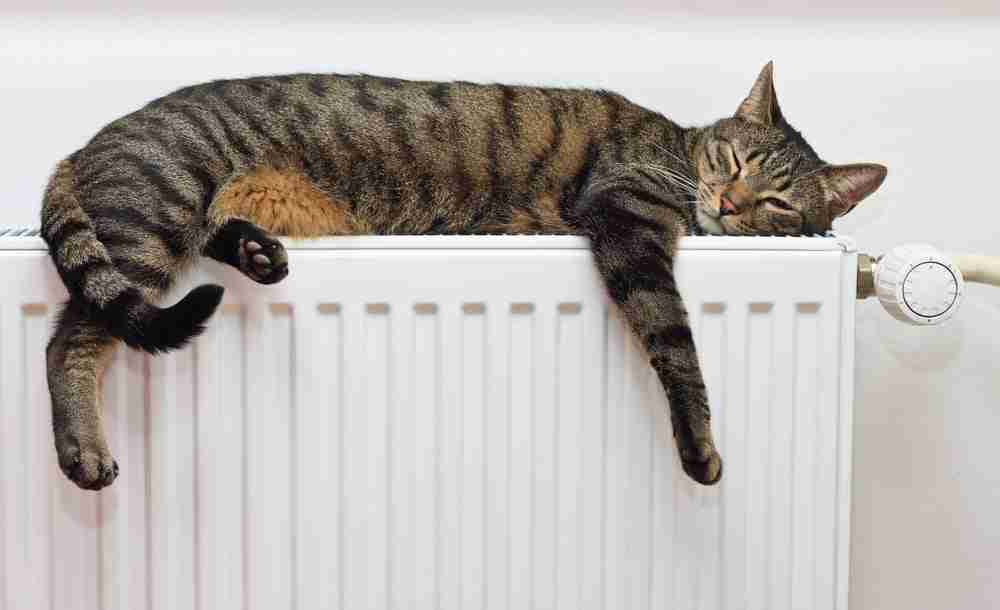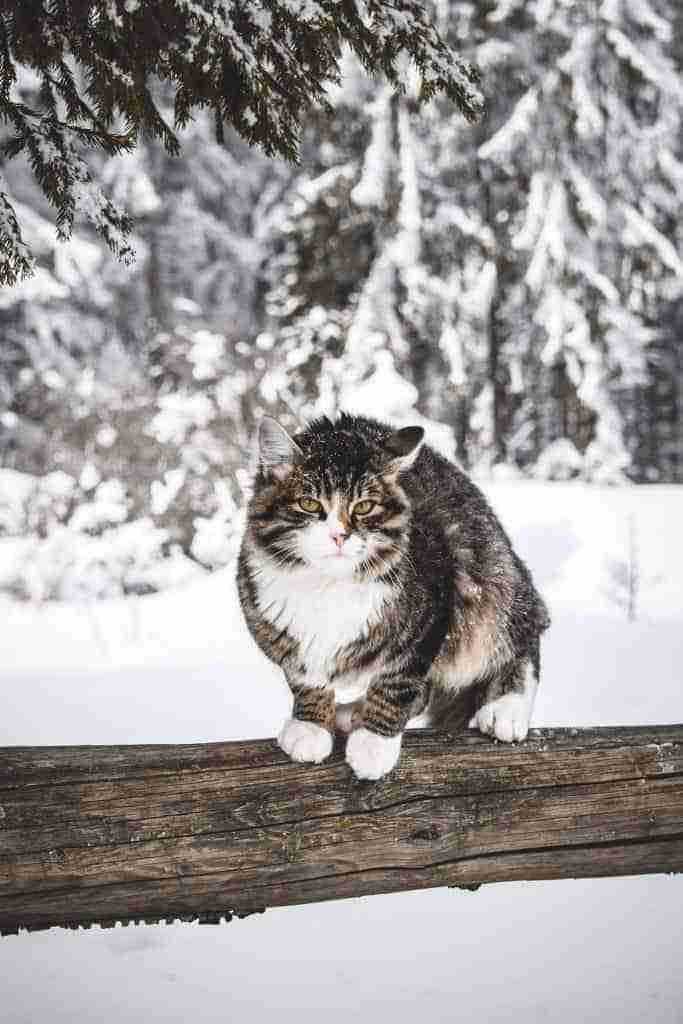How can I warm up my cat? Have you got a cold cat or kitten that needs some warmth? The safest way is probably to feed them, play with them, and provide bedding off the floor. Read on to learn more…
When the winter rolls around, humans aren’t the only ones that feel the cold. While cats have a thick layer of fur, they still get chilly when the mercury drops. In these circumstances, you might ask “how can I warm up my cat?“
How cold is too cold for cats?
Typically, a cat’s body temperature fluctuates between 99.5° and 102.5° Fahrenheit. When your kitty’s body temperatures get below 99°F, they start to feel the onset of mild hypothermia. Your cat can suffer from hypothermia when exposed to temperatures of 45°F or less – so really your cat can start to feel chilly from the same temperature down.
How Can I Tell If My Cat Is Cold?
Since your cat doesn’t speak English, it can’t tell you when it’s feeling cold. However, your kitty presents a range of body language and behaviors that let you know they need warming up.
Check for these signs in your cat to see if the cold is affecting them.
Cold Paws and Nose
Your kitty’s extremities start to lose body heat first. The nose, paws, and tip of the tail will feel cold to the touch. If that’s the case, your cat is feeling cold and could use some warmth.
Sleeping on Heat Sources
You might find your cat sleeping on heat sources around your home like the radiator or heat grate, or even on the hood of your car after you get home from work.

Curling
Sure, curling is one of your cat’s favorite sleeping positions. However, if they’re doing it more than usual, it’s probably feeling cold. Check if your cat is tucking its tail and paws under its body – that’s a sign of feeling chilly.
Increase in Affection
If your cat refuses to leave your lap in the evening, it’s because they love you – and they’re probably feeling cold. Your lap acts as a heating pad, keeping them warm.
Can Cats Turn Hypothermic?
Any animal can turn hypothermic if its body temperature drops too low. Here are the symptoms of hypothermia to watch for in your cat.
Mild hypothermia signs include the following.
(Body temperature between 90-99°F)
- Lethargy and weakness
- Shivering
- Loss of alertness.
Moderate hypothermia signs include the following.
(Body Temperature 82-90°F)
- Stiff muscles.
- Unresponsive to your calls.
- Shallow breathing.
- Low blood pressure.
Severe hypothermia signs include the following.
(Body temperature under 82°F)
- Dilated and fixed pupils.
- Faint heartbeat.
- Shortness of breath.
If your kitty is displaying any hypothermia signs, wrap them in a blanket, put them in the carrier, and head off to the vet for a checkup.

How Can I Warm Up My Cat?
Most cats are fine with indoor temperatures around the house ranging between 50 to 60°F. However, when the mercury drops below 45°F, they’re going to start having problems. Older cats will get colder faster, losing body heat quicker than younger cats.
If it looks like your kitty is feeling cold, here are a few options to help you warm them up.
Blankets
Wrapping your cat up in a blanket is a great way to get them warm. However, make sure you use a loose wrap; cats don’t like it when the blanket restricts their movement. Flannel is a cozy and comfortable material for cats and allows for airflow through the fabric, stopping your cat from overheating.
Get Your Cat a Cozy Bed
If your cat sleeps on a bed (not your bed as many cats like to do), make sure it’s off the ground during the winter. The cold penetrates the bed’s base, making them feel cold – it’s especially bad if you have tiled floors.

Some beds come with heating pads integrated into the lining. However, it’s important to note that these heating pads have a specific design for your cat. Don’t grab a heating pad from an aquarium or reptile enclosure and use it in your cat’s bed.
These heating pads are for cold-blooded animals like fish and snakes. Adding them to your cat’s bed will overheat them. If you decide to go with a heating pad, make sure you check up on your cat frequently during the first few days to ensure they aren’t overheating.
What If My Cat Doesn’t Have a Bed?
If your cat doesn’t have a bed, then build up a nest of blankets in their favorite spot on the floor. If they already have a blanket, add a pillow and a few more to make it a comfortable space for your kitty.
If your cat insists it must sleep on the floor, the blanket and pillow strategy gives them something to dig around and bury themselves in when they feel chilly.
Space heaters are another solid option for keeping your kitty warm during the cold winter evenings. Space heaters are cheap to run and very effective at heating single rooms.
Make sure you keep plenty of clearance away from your cat’s sleeping area. Leaving the heater too close to your kitty may overheat them. If your cat is feeling cold, it will move into a comfortable range in front of the heater to get warm.
Make sure the space heater is secure, as cats have a habit of knocking stuff over. Also, make sure your space heater doesn’t have exposed elements that could set your cat’s fur on fire if they get too close.
Feed and Play With Your Cat
Playing with your kitty is one of the best ways to warm them up. Your cat’s average body temperature is around 99.5 and 102.5 F, and it takes your cat more effort to maintain its temperature range in the cold.
As a result, your cat burns more calories when they start feeling cold, as the body uses more fuel to maintain its temperature. You might have to increase your cat’s food intake by 5% during the winter months, especially if they enjoy going outdoors during the day.
After sorting out your cat’s winter diet, start playing with them some more. Playing with your cat boosts their internal core temperature – think about how you feel after a session on the treadmill.
Playing with your cat in the evening also helps to tire them out. Buy your cat some new toys and spend as much time playing with them as you can, they’ll sleep soundly at night, and they won’t bother you mewing because they’re feeling cold.

In Closing – Some Final Tips for Warming Up Your Cat
Let’s wrap up with a few additional tips for keeping your kitty warm in winter.
Make sure you position their bed or blankets in an area of your home that’s away from drafts. Many cat owners tend to keep the litter box in these areas of the home, and that going to cause your cat to feel cold while they’re doing their business.
Keep the litter box out of the garage or bathroom until the weather warms up. It’s a good idea for homeowners to winterize the doors and windows around the home, sealing them from the cold. It’s an inexpensive process, and it will save you money on heating costs during the winter.
Another option is to get your cat a sweater. Not all cats like being wrapped up in a jersey, but some find it enjoyable – give it a try and see how your cat responds.